Most everyday people don’t know what the term ‘heuristic play’ means. However, almost everybody will witness it at some times in their lives.
It is something that has always existed, and seems really natural and simple.
But what, in a simple answer, is heuristic play?
Heuristic play is exploring a range of objects in different ways, and moving around with them in a safe environment. It normally happens between the age of 1 and 2. It is based around curiosity, and on a child’s developing ability to experiment and find out for themselves.
That is heuristic play in a nutshell.
It is playing with empty boxes after the toys have been taken out. It is playing with pots and pans, or material in a laundry basket.
Any simple playing with objects, and moving about with them in different ways, is heuristic play!
But of course there is so much more to it than that. When was it invented? How do you set it up? What benefits does it have? What do you need to try out heuristic play? What ages of children does it work with?
This article will answer all these questions, and more!
Heuristic play can be done equally well either at home or in an educational setting, and this article is for both parents and educators alike!
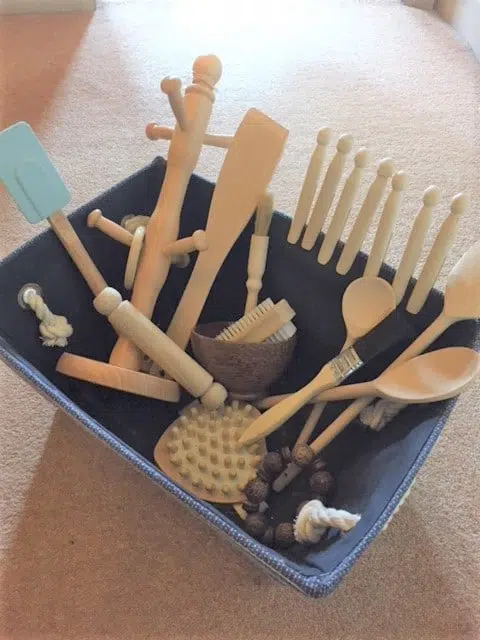
What Heuristic Play Is
Heuristic play is one of the natural things that will have always existed. It exists around the world, across different cultures, and the vast majority of the planet do not know that it is called ‘heuristic play’.
The term was first coined by the child psychologist Elinor Goldschmeid. She developed her theory of it in the 1980s.
Her idea is based around a few principles:
- Heuristic play will look different in different parts of the world. Children will be using objects that are commonly found in that country. It is not the objects that matter, but that children have freedom to access them independently
- It is a very child-led form of learning. The adult is there mainly to supervise for safety
- It can be done alone by one child, or children can access it together
- Sometimes children will share spontaneously, sometimes they won’t!
- It is done in a specific ‘session’. There is a start and an end time
Probably the most important thing about heuristic play is movement!
Children have to be able to move around before they can get involved with it.
They must select objects, and move them about the space. As a concrete example, a child might pick up a cardboard tube, and roll it round the room. They might try to put it onto something else, or wrap it up in a piece of material.
This is heuristic play in action!
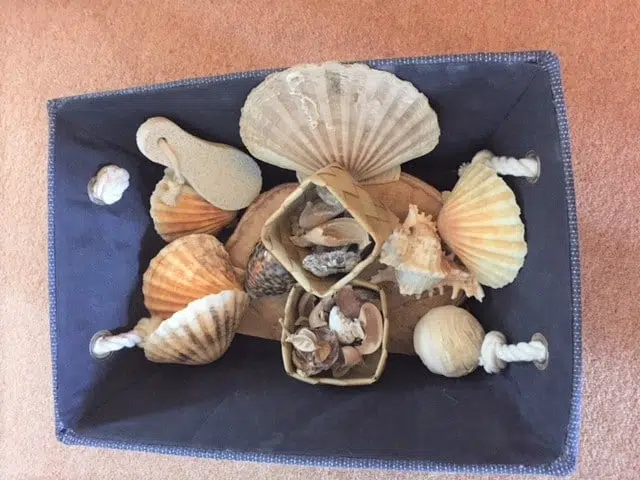
What Age Are Children Best Able To Get Involved In Heuristic Play?
Children are able to get involved in this type of play from whenever they can move around by themselves. This often happens between the age of 1 and 18 months.
Heuristic play can carry on to the age of 2 and even 2 and a half.
Some children with special needs or mobility issues may be unable to move around independently. However, they can be supported to move, and still encouraged to engage with the resources.
What Does It Look Like?
In it’s simplest form, heuristic play will take place in a designated space with enough space for the children to move around freely and safely.
There will be baskets of random everyday objects. The children will select objects and do some of the following skills:
- Stack
- Handle
- Transport
- Roll
- Post
- Gather
- Select
- Fill
- Manipulate
- Dump them!
- Cover
They are led by their curiosity and their own ideas.
What Are The Benefits Of Heuristic Play?
There has been several pieces of largescale research into the benefits of heuristic play (Source) , and these have found numerous positive findings.
I have written a full article about the 18 benefits of heuristic play that you can find here, but here are 5 of the most important benefits for you now:
1.Independence
This is a key area of the early years in general, and really important in heuristic play.
In this form of learning, children are completely in charge of what they do. They are able to:
- – Select what they use
- – Decide how to use it
- – Construct and de-construct ideas
- – Share or not share!
This level of independence is brilliant for many things. It develops their thinking. It boosts engagement. It bolsters their sense of self-esteem, and their awareness that they are able to think and act for themselves.
Independence is a real cornerstone of all early education, and a massive part of all our of online courses that you can find here.
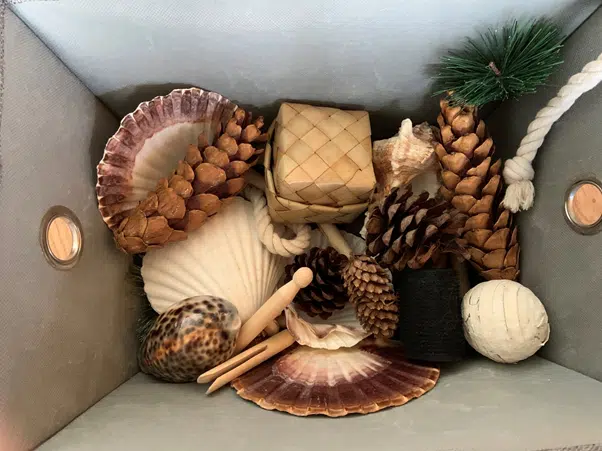
2.Flow/Concentration
This one is massive!
At this young age, children often have quite a short attention span. They flit between objects, places and ideas.
Heuristic play is excellent at lengthening this attention span. Because children are curious about the objects involved, they become fully engaged in manipulating them.
Some children will engage with an object for as long as ten minutes. This continuous flow of thinking is brilliant for brain development.
They will often achieve a sense of ‘flow’. This is the state where you become completely involved in what you are doing. It is basically the same as the sporting concept of ‘getting into the zone.’
When children are in this state, their learning is heightened, and their potential for concentration increases.
3.Creativity
Children will be trying out all sort of imaginative ideas!
They might try to stack some boxes.
They may wrap a wooden spoon in a scarf.
They may roll a round piece of wood across the floor.
These are all ideas they have invented themselves, and they are testing spontaneously as each new idea arrives.
4.Problem Solving
Things will go wrong in heuristic play, and also children will find things out.
They might try to post something that is too big into a box.
They might try to make something roll that simply can’t.
They will learn about the physical properties of objects, and also learn how to formulate ideas when things don’t go to plan.
5.Gross Motor Skills Development
There will be a huge amount of physical development going on in this type of play. Children are continuously moving in different ways. They will be bending, leaning, crawling, walking, rolling, and exploring the objects at the same time. If you want to find out the difference between fine and gross motor skills, then check out the main 12 differences.
Gross motor skills are large movements of muscles in the arms, legs and torso, and all of those will be getting a workout in this style of play!
Some crucial gross motor skills involve
- Transporting and carrying objects
- Picking things up
- Wrapping things up
- Posting things
- Stacking and rolling things
- Bouncing and dropping
The Adult’s Role In Heuristic Play
Adult’s take very much a back-seat in heuristic play.
It is a child-centred form of learning whilst it is actually happening.
However, adults have a crucial role is designing the experience, and setting up the play so that it can be as successful and as effective as possible.
Here are the key roles of the adult in heuristic play:
1.Selecting Materials
This is probably the most important bit!
Select a range of materials that children can explore. Select things based on their unusual properties, such as their texture, or their shape.
There is a lot more about the sorts of items you can pick in the next section below.
2. Designing The Environment
Crafting a space where heuristic play can happen is pretty simple. However, it’s good to know a few key pointers.
Think about safety!
Children are going to be moving around with numerous objects, so avoid sharp corners, trip hazards, or anything else like that.
It is best to have a good wide space in the room somewhere that is reasonably contained.
Have heuristic objects in simple baskets that you can put on the floor so the children are able to look into them, and select whatever they like out of them.
3. Supervising For Safety
The main role of the adult when heuristic play is actually happening is supervising for safety.
You may have to sort out some minor squabbles. Also, there may be the odd injury that happens by mistake (or you may be able to stop it before it happens)
4. Observing What Happens
Observe whilst it is going on!
What are children interested in? How are they using things?
What are their favorite objects? These are the things to use again and again.
What are they not interested in? Watching will help you understand the children more, and also help you plan heuristic play sessions in the future.
5. Helping Everyone Tidy Away
This is no easy task! But trying to encourage everyone to tidy away at the end is a key role of the adult.
What A Session Looks Like
This is really quite straightforward.
The big thing to think about is that you want to have a start of the session and an end. It is not a type of play that is going to be happening all the time in your setting or home.
Simply bring out the heuristic boxes and let the children explore.
It is up to you to judge when a session is coming to an end. Give them time to explore everything, but if children appear bored or restless (or just starting to go that way), then it is definitely time to stop.
Often when you repeat heuristic play regularly, the attention span of the children will lengthen.
At the end of the session, make it clear to the children that the session has ended, and all help each other put the stuff away!
Then put the heuristic boxes away ready for next time. It’s that simple!
Materials For Heuristic Play
You really can be very imaginative and original in sourcing objects for heuristic play, but here are a few ideas to get you going:
- Measuring spoons, ladels,
- Egg boxes
- Cardboard tubes
- Small gutters and pipes
- Greaseproof paper
- Bubble wrap
- Rubber door stops
- Jar rings
- Corks
- Napkin rings
- Keys on a ring
- Whisks
- Teapots
- Coloured ribbons
- Tea strainers
- Fruit, such as a lemon
- Pots and pans
- Paper and cardboard
If you want to find out the kinds of materials that are great for loose parts play in general, then check out this list of at least 100 ideas.
The other thing you require are some baskets. These should be heavy enough not to collapse or fall over when the children get things out of them.
They should also be reasonably low so they can look in and take things out. Other than that, pretty much any type of basket will do the trick!
Themed Baskets For Heuristic Play
Often it is a good idea to have a theme for the basket of items you will use. This is when everything in the basket shares some kind of property.
Some great ideas for themed baskets include:
Wooden Basket
This is as easy as it sounds! Just select loads of wooden items. Ideas could be wooden spoons, pegs, sticks, wooden blocks
Things That Smell!
The more multisensory the objects are the better! This really deepens the curiosity of the children, and their sense of excitement in interacting with the objects.
Some great ‘smelly’ objects include things like lemons, limes, grapefruit, herbs, or scented bags.
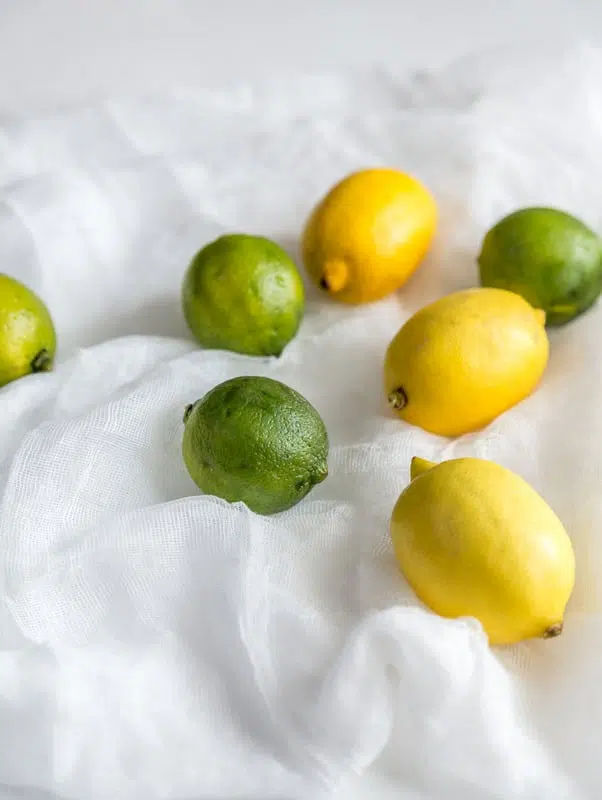
Black/White
Children find the contrast between black and white really stimulating.
Have a heuristic basket containing objects of just these two colors can really spark their interest, and be really visually exciting.
Some black or white things could be material, objects, clothes – anything you can find!
Metal Basket
Raiding the kitchen in particular is a brilliant source of objects for a treasure basket!
Some great metal items include things like ladels, spoons, forks, pots, pans, bowls, and any other pieces of metal you can think of.
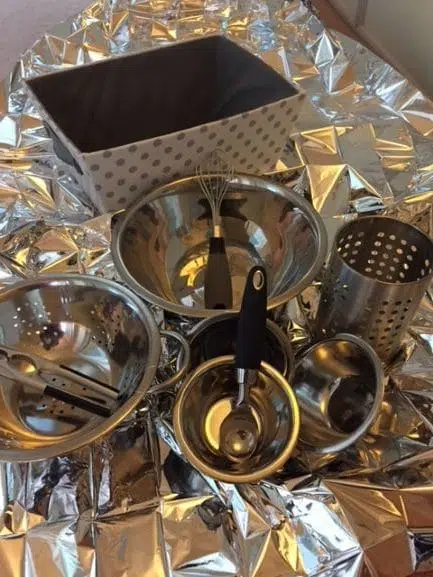
Soft Items
Soft materials can be manipulated in many different ways that hard objects cannot.
For example, you can wrap them round things. You can wear them! You can put them over your head so you can’t see!
Some great ideas for soft things could be velvet, wool (either a ball or knitted), scarves, handkerchiefs, baby clothes, socks.
Noisy Items!
Things that make a noise are great for exploring with, as well as being excellent for developing children’s sense of listening and attention.
This leads into their communication, and is also laying the foundations for early literacy and phonic development later on.
Some good noisy items include dog toys, crinkly paper, foil, and bubble wrap
To find out a full list of many treasure basket theme ideas, then check this in-depth article out. Many treasure basket resources can be used in heurisitc play.
What Happens Before Heuristic Play
Before heuristic play there are treasure baskets. To find out exactly what they are then look at this.
These can be accessed by babies whenever they are able to sit up (with support if required).
Treasure baskets are wicker baskets that contain a range of random everyday materials. The children sit next to the basket, and explore the objects. Just like with heuristic play, they will:
- Explore what objects feel like
- Examine their physical properties, like weight and shape
- Investigate what they can do with them
This type of play feeds in perfectly to heuristic play.
What Happens After Heuristic Play
Heuristic play blossoms into loose parts play.
This is experimenting with random objects in a range of contexts. Once again, it is a very child-led form of play.
It differs from heuristic play in that it does not always involve movement. You can move around with the objects, but you can also investigate them in one place.
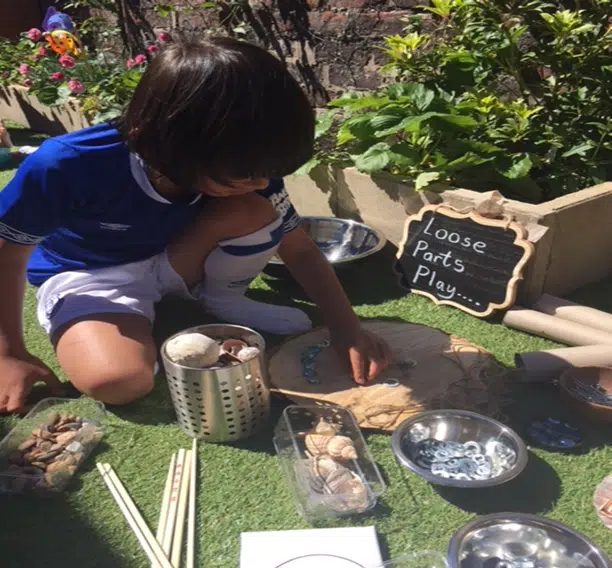
Also, older children will be able to explore many more smaller items, and also use them in different contexts.
Some great loose parts play activities include:
- Transitional art with random objects
- Printing and manipulating dough with different loose parts
- Creating images such as maps
- Using loose parts in role play to represent different things
- Investigating different concepts such as gravity or floating and sinking.
If you want to find out a full in-depth guide onto the sorts of activities you can try out with random objects, then check out these 40 fantastic loose parts play ideas.
Top Tips For Heuristic Play
- It is really cheap or free!
- Select a of interesting materials that have unusual properties
- If children enjoy a specific object, then use it again
- Rotate the objects used to keep it fresh!
- Have a specific start and end time to the session
- Let the children interact independently. Try to take a back seat!
What Next…
Heuristic play is a crucial form of learning for children between the ages of 1 and 2. It is a natural process, that happens by itself with only a bit of prompting and setting up.
If you are really passionate about setting up an outstanding provision where heuristic play can flourish, then check out our course ‘Project Loose Parts’. This 2-hour video course provides a full step-by-step guide in how to get started with loose parts play for all ages, as well as more than 100 practical ideas. You can check out our Project Loose Parts course here.
This article is an expanded extracted from the book ‘Loose Parts Play – A Beginner’s Guide’ written by myself and my colleague Debby Stevens. This book provides a full, yet simple guide to setting up an outstanding loose parts culture in your home or educational setting with children aged 0-5. To check out the book on Amazon, then follow this link
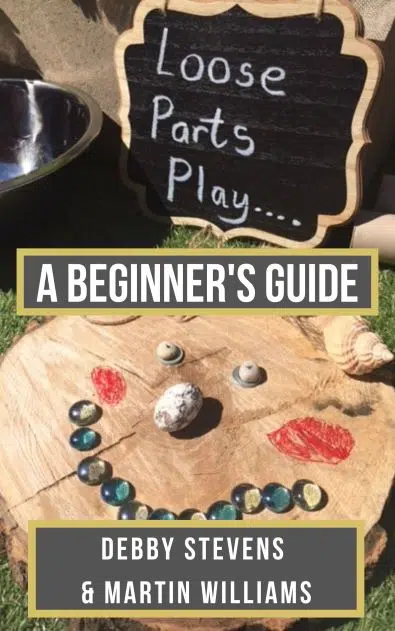
If you have found this article beneficial, then why not check out one of these:
